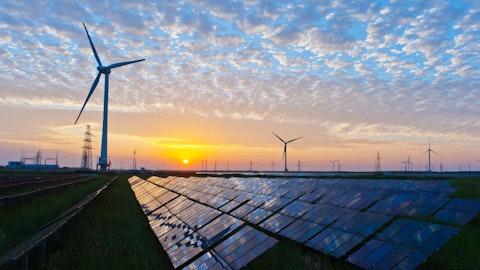Julien Dumoulin-Smith: Excellent. All right, guys. I’ll leave it there. Best of luck. I see you soon.
Operator: Our next question is coming from the line of Durgesh Chopra with Evercore ISI. Please go ahead.
Durgesh Evercore: Dan, just — I don’t want to jump the gun on ’24 here, but just wanted to sort of last year EEI, you were clearly sort of — you guys were articulating headwinds from rates and I think the ’24 numbers were subsequentially brought down. How do you think about sort of ’24 year again? Just qualitatively, obviously, there’s headwinds from rates that keep going higher, but then you’re showing a stronger load forecast prospectively. So, the puts and takes, how would you kind of articulate where ’24 is shaking right now versus your expectations at the beginning of the year?
Chris Womack: Let me start by saying I mean, I think we — as I said earlier, I mean, that is the things you’ve mentioned, that’s part of the process we’re in the middle of now that will lead us to February when we give you our ’24 guidance, but assessing the tailwinds that we are really excited about from economic development activities to the headwinds of interest rates. I mean that will all go into the calculus to the process of us kind of coming forth in February with our guidance for ’24. But I think it’s just a tab bit premature. And you’ve seen us in terms of how we do this. But we don’t give you any kind of indication or guidance at this point in time. We’ll do that in February of ’24.
Dan Tucker: Yes. And I guess it’s just a matter of discipline for us. This is you could go back to every third quarter transcript, script ever, and you’re going to hear the same answer. But I think it’s fair to say where we are. Chris and I are really excited about. Our value proposition I would stack up against anybody else’s right now.
Durgesh Evercore: Okay. I tried it at least.
Chris Womack: It was a good try.
Durgesh Evercore: Just maybe then just shifting back to discussion to the CapEx upside. How much — so obviously, billions of dollars, would you think of customer bill impacts. I guess where I’m going with this is there’s a pretty sizable load growth forecast that you were suggesting mid- to high single digits what percentage of that CapEx you think would go towards or the return would be satisfied by the slowed forecast versus increasing rates, if you could talk to that a bit.
Dan Tucker: Sure. Look, there’s a lot of moving parts here, as you can imagine. And I don’t want to get ahead of the regulatory process and things that will be evaluated in terms of the ultimate resource plan that’s decided on. But stepping back at a really high level, everything that we see from a load growth perspective relative to the resources needed to serve this growing peak load, and that’s key, right. You invest to make sure you can meet the peak loads, but the customers that you’re adding aren’t just using electricity at the peak, and it just so happens, the customers that we’re adding are expected to use electricity oftentimes 24/7. And so that kind of profile will provide more than sufficient revenue at the rate structures that exist today that is needed to pay for that capital. That is where the economic benefits for other customers have the opportunity to really help with this affordability equation.
Operator: Our next question is coming from the line of Andrew Weisel with Scotiabank. Please go ahead.
Andrew Weisel: Andrew, Okay. So first, it’s a quick one. Third quarter was obviously well ahead of the estimate. I know part of that is weather, but you’re still pulling to the midpoint of the full year range rather than something higher. Forgive me if I missed it, but what are the offsets relative to your outlook three months ago?
Dan Tucker: So, we didn’t really update the year-end three months ago. Again, just as that same discipline, we only address year-end on our third quarter call. And so it’s the first time we’re really refining it. It’s really about the first half of the year. Yes, we had a better-than-expected third quarter, but the headwinds of weather in the first half were pretty substantial. And that’s why we’re $0.34 below last year on a year-to-date basis. And so that’s the biggest driver of kind of the middle of guidance expectations at the end of the year. Now I say all that, Andrew, I mean, again, we put out quarterly estimates all the time, and I kind of challenge you to go back and find a time where we didn’t exceed that. So that should help with where our expectations are.
Andrew Weisel: Yes, definitely. Okay. Got it. So you’re back on track now, I guess, I could say. Next question is on Georgia, IRP. I know it’s off cycle. The typical cadence would have been to wait until 2025. How receptive are the regulators to this? I assume you’ve had conversations with the key intervenors. Is there any reluctance to breaking that three-year pattern? And as a follow-up, is there any thought to postponing some plant retirements? I know you talked about what you’re going to add and maybe sign contracts for existing assets, but any thoughts on postponing some of your retirements?
Chris Womack: Let me take a shot at a couple of things. And first of all, we never get ahead of our regulators. Secondly, I’d say as we were going through the ’22 IRP process, we did socialize and bring forth to the commission the activity that we saw occurring that there was a likelihood that there would need to be some update filing in between the three-year cycle. So this is not necessarily a surprise. We did mention that this would, in fact, be forthcoming. But yes, so we will go through the process, and hopefully, we’ll get a decision sometime by April of ’24 with this updated IRP. And what was the second part of your question?
Andrew Weisel: Potential to postpone plant retirements.
Chris Womack: As you look at this need that is there, that there is the likelihood that we would need some traditional units a little longer. Meaning, I think as we look at units that may have been scheduled to retire in ’28, we may look to take them into the 30s. So that is a possibility as we look to respond to this growing demand for our customers.
Dan Tucker: And while that’s an assumption in this IRP update, I think that will be a decision to be made in a future IRP proceeding in terms of those existing coal units.
Andrew Weisel: Okay. And just to clarify that you’re requesting a decision in April. Does that mean the CapEx update in February will not reflect anything related to this that will wait until February of 2025?




